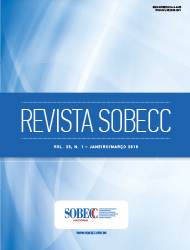Nurse role in robotic surgery: challenges and prospects
DOI:
https://doi.org/10.5327/Z1414-4425201800010008Keywords:
Robótica. Enfermagem. Sala de cirurgia. Procedimento cirúrgico. Procedimento cirúrgico minimamente invasivo.Abstract
Objective: To identify the main challenges and prospects of the nurse’s role in robotic surgery. Method: Integrative review carried out in the
Literatura Latino-Americana e do Caribe em Ciências da Saúde (LILACS), PubMed and Science Direct databases, of articles published between 2008 and April
2015; sample consisted of 11 articles. The data analysis was carried out by synthesizing the information obtained according to the objective, seeking to
identify evidences. Results: The search resulted in the identification of 281 studies, 225 in ScienceDirect, 51 in PubMed and 5 in LILACS. Eleven studies
meeting the inclusion criteria and the guiding questioning presented here were selected, being 9 qualitative ones, 1 systematic review of randomized clinical
trial and 1 validation study. Conclusion: The challenges presented were: patient safety, team training and skills development. Regarding the possibilities,
a new area of development, the importance of permanent education and innovation for the improvement of care of surgical patients were observed.
References
Sousa CS, Bispo DM, Cunha AL. Capacitação em cirurgia robótica no programa
de residência em enfermagem perioperatória. Rev SOBECC. 2016;21(4):198-202.
Morin E. A cabeça bem-feita: repensar a reforma, reformar o
pensamento. Rio de Janeiro: Bertrand Brasil; 2000.
Baggio MA, Erdmann AL, Sasso GT. Cuidado humano e tecnologia na
enfermagem contemporânea e complexa. Texto Contexto Enferm.
;19(2):378-85.
T ramontini CC, Lopes DF , Kikuchi EM, Kemmer LF , Garanhani ML.
Repensando a formação do gerente do processo de trabalho do
enfermeiro de centro cirúrgico e centro de material. Rev SOBECC.
;7(1):11-5.
Sant’Anna RT, Prates PR, Sant’Anna JR, Prates PR, Kalil RA,
Santos DE et al. Emprego de sistemas robóticos na cirurgia
cardiovascular. Rev Bras Cir Cardiovasc. 2004;19(2):171-8. DOI:
1590/S0102-76382004000200012.
Lemes C. Tempos modernos? Rev Onco [Internet]. 2011/2012
[acesso em 2014 ago. 4];9:12-6. Disponível em: https://issuu.com/
revista-onco/docs/onco-ed.09.
I nstituto Nacional de Câncer José Alencar Gomes Da Silva (INCA). O
futuro chega à sala de operações do INCA. Rev Rede Cancer. 2012;7:10-2.
O liveira MA. Gerenciamento de novas tecnologias em centro cirúrgico
pelas enfermeiras nos hospitais de Feira de Santana, BA. Rev Bras
Enferm. 2004;57(3):292-7. DOI: 10.1590/S0034-71672004000300007
Alves AF, Grassia RC, Carvalho R. Cirurgia robótica de revascularização
miocárdica: em busca de evidência científica no uso da tecnologia
do século XXI. Rev SOBECC. 2012;17(3):31-42.
Oxford Centre for Evidence-Based Medicine (UK). Levels of Evidence
Working Group [Internet]. Oxford: CEBM; 2011 [acesso em 2017 Jan.
. Disponível em: http://www.cebm.net/wp-content/uploads/2014/06/
CEBM-Levels-of-Evidence-2.1.pdf.
Brasil. Lei nº 9.610, de 19 de fevereiro de 1998. Altera, atualiza e consolida
a legislação sobre direitos autorais e dá outras providências. Brasília; 1998.
Schmock BA. Technological advances in the operating room. Pa
Nurse. 2009;64(1):13-28.
Booth BE. Robotics in nursing. J Pract Nurs. 2011;61(4):12-3.
U lmer BC. Best practices for minimally invasive procedures. AORN
J. 2010;91(5):558-72. DOI: 10.1016/j.aorn.2009.12.028
Sweeney P. The effects of information technology on perioperative
nursing. AORN J. 2010;92(5):528-40. DOI: 10.1016/j.aorn.2010.02.016
Zender J, Thell C. Developing a successful robotic surgery program in a
rural hospital. AORN J. 2010;92(1):72-83. DOI: 10.1016/j.aorn.2009.10.024
Stanton C. Keeping up with technology. AORN J. 2011;93(1):8-9.
T homas CC. Role of the perioperative nurse in robotic surgery. Perioper
Nurs Clin. 2011;6(3):227-34. DOI: 10.1016/j.cpen.2011.06.005
Walters L, Eley S. Robotica-assisted surgery and the need for
standardized pathways and clinical guidelines. AORN J. 2011;93(4):455-
DOI: 10.1016/j.aorn.2010.05.032
M ills JT, Burris MB, Warburton DJ, Conaway MR, Schenkman NS,
Krupski TL. Positioning injuries associated with robotic assisted
urological surgery. J Urol. 2013;190(2):580-4. DOI: 10.1016/j.
juro.2013.02.3185
Nayeemuddin M, Daley SC, Ellsworth P. Modifiable factors to decrease
the cost of robotic-assisted procedures. AORN J. 2013;98(4):343-52.
DOI: 10.1016/j.aorn.2013.08.012
L ee CC, Lin SP, Yang SL, Tsou MY, Chang KY. Evaluating the influence
of perceived organizational learning capability on user acceptance
of information technology among operating room nurse staff. Acta
Anaesthesiol Taiwan. 2013;51(1):22-7. DOI: 10.1016/j.aat.2013.03.013
Ballone GJ. Humanização do atendimento em saúde. Psiq Web
[Internet]; 2008 [acesso em 2017 Jun. 10]. Disponível em: http://
www.psiqweb.med.br/site/?area=NO/LerNoticia&idNoticia=251.
Paschoal AS, Montovani MF, Méier MJ. Percepção da educação
permanente, continuada e em serviço para enfermeiros de um
hospital de ensino. Rev Esc Enferm. 2007;41(3):478-84. DOI: 10.1590/
S0080-62342007000300019
A mestoy SC, Schveitzer MC, Meirelles BH, Backes VM, Erdmann
AL. Paralelo entre educação permanente em saúde e administração
complexa. Rev Gaúcha Enferm. 2010;31(2):383-7. DOI: 10.1590/
S1983-14472010000200025
Downloads
Published
How to Cite
Issue
Section
License
By publishing in Revista SOBECC, authors retain the copyright of their article and agree to license their work using a Creative Commons Attribution (CC BY 4.0) International Public License, thus accepting the terms of this license. The CC BY 4.0 license allows others to distribute, remix, adapt, and create from the published article, even for commercial purposes, provided they give due credit to the creators of the work (authors of the article).
The authors grant to Revista SOBECC the right of first publication, to identify itself as the original publisher, and grant to the journal a non-exclusive license to use the work in the following ways: (1) to sell and/or distribute the article in hard copies and/or in electronic format; (2) to distribute parts and/or the entire article in order to promote the journal through the internet and other digital and printed media; (3) to record and reproduce the article in any format, including digital media.
With this license, authors can enter into separate contracts for non-exclusive distribution of the article (e.g., publishing in an institutional repository or as a book chapter), with acknowledgement of authorship and initial publication in Revista SOBECC. Authors are encouraged to publish and distribute their work online after publication in the Revista SOBECC, as this can increase the article's visibility and impact.
In line with the journal's policies, each published article will be assigned a CC BY 4.0 license, which will be visible on the abstract page and in the PDF of each article with the respective link to the license terms.











